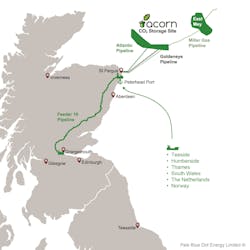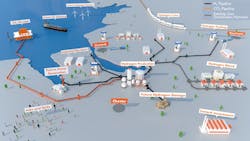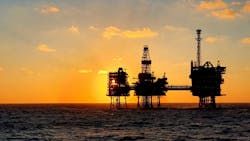UK offshore sector adapting to changing energy priorities
UK North Sea operators face mounting pressures as they seek to sustain E&P activity. Delivering returns to investors in a time of global crisis has to be juggled with demonstrating to a skeptical public their social license to continue offshore operations. Senior representatives from various companies outlined their concerns and potential solutions at the SPE Virtual Finance and Investment Conference 2020, staged late last year.
COVID-19 has not so far checked the rapid growth of wind farms across the UK North Sea. However, as Steve Phimister, VP Upstream Director at Shell UK, pointed out, oil and gas still accounts for 75% of the UK’s energy, and will remain a big source for decades to come. “We need to produce all the oil and gas we can to drive key industries such as shipping and road freight. The question is, how do you make the right change?
“The UK government has set a target of net zero by 2050. The North Sea and the North Sea basin has a role to fit into that objective, providing a combination of water depths, wind speeds, and subsurface geology that is good for CO2 sequestration. It also has a strong supplier base with years of capability and experience dealing with transitions in the past and in recent history. So it is vital to put together a multi-decade plan for the North Sea to play its part in the transition to a low-carbon industry, and that means we have to ensure our own base is net zero by 2050. Our technologies, innovations, and capabilities will take us forward, but at the same time, government policy can change, so we need to be ready to go faster or slower – how we interface and work with all of this is critical.
“So what are the next steps for the UK upstream industry? Four to five years ago, we were barely discussing net zero in the UK, now it dominates every topic in every forum. We have to come together strongly as an industry to collaborate. In the UK, Shell spent the past year working on an Upstream Decarbonization Roadmap, and we are one of the first companies on the UK continental shelf to set a target. Oil and Gas UK’s 2035 roadmap is another example, looking at how to reduce UK offshore emissions 50% by 2030 (equivalent to 8 MM t/yr of CO2), and then 90% by 2040. Methane management is key, but that’s a relatively easy starting point. Much more economically challenging projects require collaboration with the government and the UK regulator in a tripartite relationship. And industry and the supply chain need to figure out how to power platforms sitting far out in the North Sea with electricity.”
To move with society, he continued, the UK North Sea industry itself needs to become net zero. “That will mean big changes to our business plan and portfolio, and to oil and gas production facilities. We will see more schemes offshore involving hydrogen production and renewable energy.”
Across the North Sea in the Norwegian sector, Shell is participating with Total and Equinor in the Northern Lights project, backed by the Norwegian government, targeting capture of CO2 from industrial sites across Norway for subsequent shipment and storage in a North Sea reservoir. By 2024, 1.2 MM t/yr of CO2 could be sequestered for storage. In the UK, another six de-carbonization developments are in the planning phase, Phimister said: Shell is supporting the Acorn project in northeast Scotland, which is investigating reformation of natural gas into clean hydrogen, and re-use of existing facilities, including offshore pipelines serving the decommissioned Goldeneye field, to transport and store 5 MMt/yr of CO2 beneath the UK central North Sea.
The company is also participating in a planned CO2 project in England for both ‘blue’ hydrogen (involving capture and storage underground of associated carbon emissions) and ‘green’ hydrogen (produced via electrolysis) – up to 10-15 MM t/yr. These schemes could reduce local industrial emissions by 50%, he claimed, and many other companies are collaborating. “However, one thing we need to progress quickly is developing business models for both carbon capture storage and hydrogen. Discussions are taking place with the government, which has put together an £800-million [$1.08-billion] fund for transport and storage. We are also trying to formulate a North Sea transition deal with the government, a crucial element of the transition of the UK North Sea industry. This will stimulate a lot of high-quality jobs, and by facilitating the supply chain’s transition from oil and gas to renewable industries, will have a dramatic impact on exports.”
Tom Wheeler, Director of Regulation at Britain’s Oil and Gas Authority (OGA), said the UKCS had responded well to last year’s crisis, achieving overall production efficiency of 80% – the highest since 2000 – with opex half the level recorded in 2015. At the same time, the sector has continued to deliver large gas-condensate discoveries such as Isabella and Glengorm, he noted, with further impetus provided by North Sea asset transactions.
There is also a realization of the need for collaboration to capitalize on big opportunities going forward, he said, with companies working together on offshore wind farms and carbon capture and storage (CCS) projects. New UK offshore oil and gas field developments, however, remain largely on hold. To aid the recovery, Wheeler said, the OGA is doing what it can to stimulate activity “in order to protect jobs and ensure the supply chain comes out of this difficult period and make the transition to the new renewables agenda and integration projects. As part of this process, the OGA is supporting the North Sea Transition Deal and the newly approved Global Underwater Engineering Hub in Aberdeen.” The latter, led by Subsea UK, is intended to help the subsea sector diversify away from oil and gas into green energy projects.
As for resuscitating conventional offshore programs halted by the coronavirus and the faltering oil price, initially the Authority took a flexible approach to license commitments. “Now, however, we are getting more robust as we look to drive new activity and progress the UK’s MER [maximizing remaining hydrocarbon resources] agenda.
“We are working on stimulating P&A on open-water suspended wells, of which there are 190 in UK waters: these could be done by joint [i.e. rig-share] campaigns which would be cheaper, and would help people that are looking for work to do. We have also launched a mediation project in an attempt to rid the sector of the long-standing sores that prevent some oil and gas companies from working together.
“Looking forward, offshore electrification will be a big part of UK licensees demonstrating their right to operate in future, with a focus on regional synergies with offshore wind…Electrifying platforms also creates a network of power for future CCS schemes.”
Phillip Hemmens, head of Eni regional management for northern Europe, said his company’s commitment to the basin was “to be a leader in the energy transition.” One initiative Eni is part of is HyNet North West, a project in northwest England that involves production of hydrogen from natural gas; construction of a hydrogen pipeline network; and creation of the UK’s first carbon capture and storage infrastructure, with first CO2 injection planned for 2025.
Carbon-dioxide captured from the local cluster of heavy industries will be stored in geologically suitable, depleted gas reservoirs at fields in Liverpool Bay in the Irish Sea. There is further potential for storage in gas reservoirs close to depletion in the Morecambe Bay fields to the north. All the fields are relatively close to the shore, which should reduce CO2 transport and storage costs. Re-purposing of the reservoirs will also reduce decommissioning costs.
Last year the OGA awarded Liverpool Bay operator Eni a license for subsurface storage of CO2 (up to 10 MM t/yr by 2030). According to Hemmens, this will involve re-use of a fixed platform, pipeline and wells serving the depleted Hamilton and Lennox fields, and construction of 40 km (25 mi) of new pipelines. Re-use of offshore infrastructure is relatively low cost compared with other storage projects, he claimed. Eni has already signed MoUs with carbon emitters in the region, and expects to take a final investment decision in 2023. The project as designed could transform the local economy, he added, and would establish the UK as a leader in the transition to hydrogen.
The initial phase of HyNet North West will target CO2 emissions reductions of over 1 MMt/yr, and direct capture of 400,000 metric tons/yr (440,924 tons) of CO2 from one of the partners’ industrial sites. The UK’s first low-carbon hydrogen plant (3 TWh/yr) would be built at the Stanlow Refinery in Cheshire, with produced hydrogen stored in nearby underground salt caverns. Eni is also leading the Ravenna Hub CCUS project in eastern Italy, which involves capturing carbon onshore, then storing it in depleted gas fields in the Adriatic Sea, via wells in the Porto Garibaldi reservoir.
But there are challenges: carbon capture in Europe is a new business, Hemmens pointed out, and governments and regulators are still developing their understanding of what is required in terms of licensing and modeling. “But there is no time to lose, we need to get industry de-carbonized. To make wells applicable for CO2 storage the OGA brought in requirements – when you abandon something, you should try to do so in a way to make them work in future for storage.
“Although there is a carbon capture association, one of the biggest problems is sharing of information between the various planned hubs. Liverpool Bay produced sour gas, so it already has chrome piping in place, which is helpful for storing CO2. But the key is to re-use as much as possible. Now we are doing two years of FEED in Liverpool Bay, to ensure that everything that we have in place is fit for storage, not for continued oil and gas production.”
To further this process, he concluded, the fledgling offshore CO2 storage industry “needs geologists, subsea expertise, and specialists in 4D monitoring of reservoirs to prove how much you are putting in and where it is going.”
Leigh-Ann Russell, BP’s chief procurement officer, said her company recognized “significant market volatility, unprecedented cross-pressures for industries and a sharp decline in demand for oil and gas.” At the same time, “BP has created a new production and operations organization that allows us to produce affordable hydrocarbons that the world needs from producing oil and gas fields and refineries. And we expect to grow our underlying production over the next 18 months, focusing more on capitalizing on the best opportunities, with an increased emphasis on leveraging our existing infrastructure…When the market is right, BP will continue to divest a number of core assets.
“Hydrocarbons still have a key role to play in the energy mix. In 2030 the world will still need 75% of the oil used today, so investment doesn’t stop when peak oil has passed. And gas supports fast-developing economies in the transition to new energy sources.”
Russell highlighted the Net Zero Teesside project as one of BP’s major contributions to the UK’s energy transitions. This is an initiative in northeast England that the company formed last February with Eni, Equinor, Shell and Total, supported by OGCI Climate Investments. It will involve constructing transportation and storage infrastructure to capture, compress and safely store up to 6 MM metric tons/yr (6.6 MM tons) of CO2 generated by local industries in a UK North Sea reservoir. A combined cycle gas turbine facility incorporating carbon capture technology will also be created to supply low-carbon power.
Gareth Wynn, at the time Stakeholder and Communications Director for industry association Oil and Gas UK (OGUK), drew attention to the fall-out of the present crisis across the UK’s supply chain. By the end of 2020, revenues had fallen by one-third, cashflow was down by half, and debts were piling up, he said, with many companies now in full-fledged survival mode. “And drilling is at its lowest point on the UKCS since the 1970s. If it had not been for the industry cutting production costs by over 50% over the past few years, we would be in worse shape.”
Many UK offshore installations remain below what OGUK would expect in terms of manning levels, and maintenance is typically still limited to safety-critical work in order to keep offshore numbers down. “But we are looking to get people back offshore to re-start work, which will in turn help the supply chain get work.
“How do we accelerate the opportunities from net zero? The OGA’s 2035 roadmap, launched in 2019, is part of that. The UK relies on oil and gas for 75% of its energy mix, with UK fields providing 51% of the gas and 74% of the oil. Our current production is significantly below the UK’s demand, and we should be trying to satisfy that demand for as a long as possible in order to safeguard our companies and jobs.
“As for net zero – offshore CCS, hydrogen production, and others – the engineering for those projects is fundamentally the same as North Sea engineering. We won’t achieve net zero in the timescale required without it. But if we can industrialize at scale, that will secure jobs. Our sector is worth £24 billion/year [$32.4 billion] to the UK, and provides work to 270,000 employees.”
Clara Altobel, VP ESG (Environmental, Social and Corporate Governance) and Business Innovation at Serica Energy, spoke of her company’s initiative to reduce emissions and waste offshore at the Bruce field production complex in the UK central North Sea. The London-based independent acquired operatorship of Bruce and the Keith/Rhum satellites from BP in 2018. As an operator, it currently produces 40,000 boe/d, of which 80% is natural gas, and delivers 5% of the UK’s daily gas needs.
Serica, which presently has 150 employees, established an emissions reduction group, drawn from offshore and onshore staff and management, and according to Altobel, was the first North Sea E&P company to sign up to logistic provider ASCO’s Zero Waste to Landfill initiative. “Nothing we have used has gone to landfill since July. What causes waste? Packaging is the worst, so we have been trialling packaging pods that are re-usable, and can seal equipment offshore.”
As for emissions, minimizing flaring is one of the OGA’s prime short-term targets. As Altobel pointed out, flaring occurs mainly during shutdowns of platforms for planned or unplanned maintenance. Depending on the duration, “that can bust your target.” Rhum is a long-distance subsea tieback to the Bruce platform which has been subject to numerous shutdowns over the years, due to sanctions concerning partner Iranian Oil Co. (UK), and more recently for intervention work to restore production through the suspended R3 well.
Re-starting operations at Rhum has historically required injection of chemical hydrates and extended flaring at Bruce. Serica has acted to modify the procedures: “It now takes longer to get production up to speed,” she explained, “but it’s only deferred, we will get the production back eventually. We also found that some of the valves were sticking and needed maintenance, but that has been fixed, so that the last time start-up occurred, there was barely any flaring.” Serica has set up a live offshore-onshore link-up to manage the process, she added.
In terms of emitted CO2, 85% of the emissions at Bruce are from fuel gas, compression and power generation. “We are looking to improve our maintenance to get this level down. We have implemented an energy audit, and now report more. It’s an iterative process, and we are seeing improvements.”
Logistics are also under scrutiny. Previously, Bruce’s needs were served by a supply vessel sailing from Aberdeen to the south. Following a tip from the supply chain, Serica switched to using a ferry that sails from Aberdeen daily to Lerwick in the Shetland Isles, which is closer to Bruce’s location in the East Shetland basin. The associated emissions are minimal, compared with a supply vessel which runs on diesel, Altobel said. Lerwick Harbour has been suffering due to the COVID-19 related cruise ship decline, and this helps them, she added. “For well interventions and maintenance needs, we are also looking at going now via Lerwick.”
Serica sees demand for gas in the UK continuing out to at least 2035, and the company is interested in taking on more mature facilities off the majors for tiebacks. “At the same time, the industry must design for net zero in longer term. The pace of change in technology is incredible, you need to take advantage of where we’re going. As an example, we are creating a digital twin of the [Bruce] platform in order to improve integrity management. We are also looking at key equipment that can be recycled.”
She cited initiatives on other projects in the North Sea, such as the Equinor-operated Breidablikk development that will connect 26 subsea wells to the Grane platform. “What they are doing is extending the life of the platform and reducing the carbon intensity. Subsea tiebacks are good environmentally, a friendly way of developing oil and gas.” Around 100 km (62 mi) east of Aberdeen, Jersey Oil & Gas is spearheading a redevelopment of the Greater Buchan Area, with plans for a new, fixed steel platform: this could receive power from a nearby offshore wind farm or directly from the shore. “Wind power is not wholly reliable, and power from UK would be costly. But it means they can design the platform to be lighter and cheaper, and that makes maintenance much less.”






